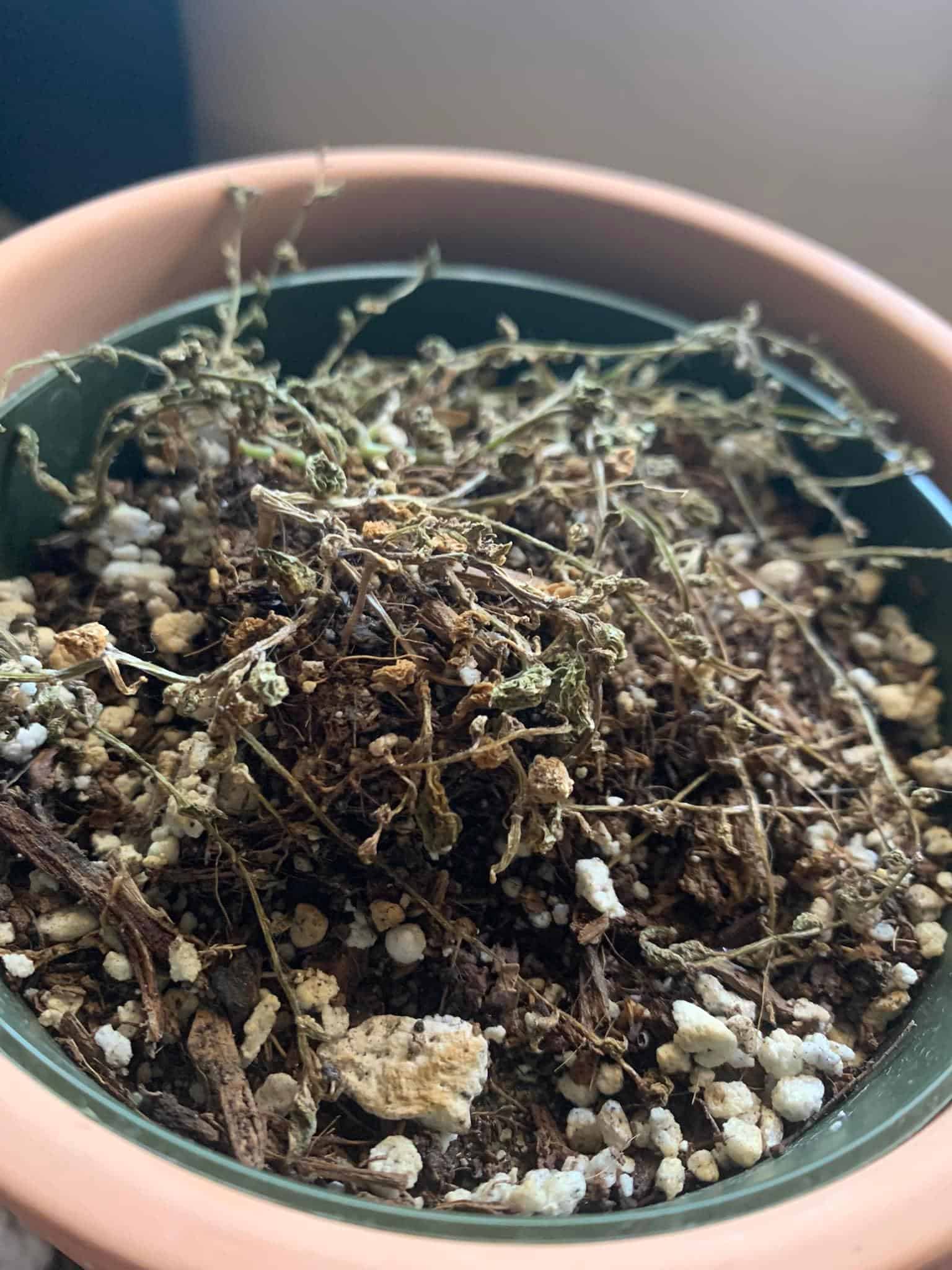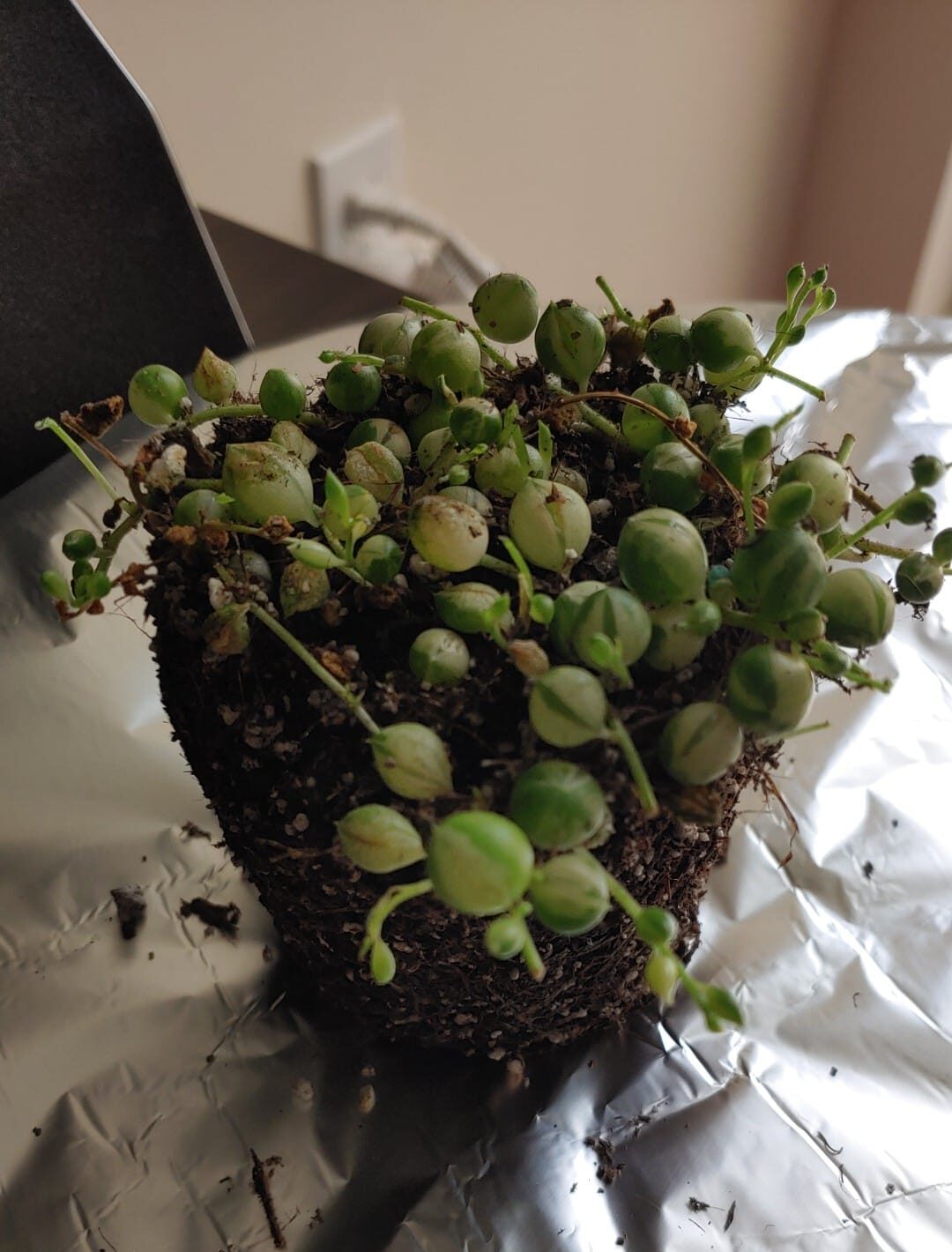Has your String of Pearls plant gradually yellowed and became mushy, eventually falling off the stem? It could be a sign of dying from improper care.
Without wasting precious time, continue reading till the end so you know how to diagnose and revive the dying String of Pearls accordingly.
Table of Contents Show
Can I Save a Dying String of Pearls?
The String of Pearls is relatively hard to care for with extensive care requirements.
So do not fret if you see a dying String of Pearls, as you can save them unless the ship has sailed already.
The symptoms worsen over time and will become irreversible. Thus, a delay in treatment can cost you the plant.
Common Reasons String of Pearls Might be Dying
A dying String of Pearls shows telltale signs like yellowing, mushy wilted leaves with limpy, weak stems, or rotten roots.
Other than that, the pearl-like foliage may also drop, develop brown spots or shrink down.
In such a scenario, you must diagnose the culprit and provide immediate revival solutions to revive String of Pearls.
1. Overwatering
Being a fellow succulent, String of Pearls stores water in their thin stems and pearl-like leaves.
When you overwater, the plant stores more water than it can handle, causing the leaf to burst out.
Likewise, excess water clogs the soil causing poor soil air circulation and suffocating the roots.
As a general rule of thumb, water your String of Pearls once a week in spring or summer via a soaking approach.
However, cut down watering once a month in the dormant winter season.
How to Revive?
- Snip off the mushy, damaged, decaying leaves and stems.
- Relocate the plant to the low humid room to increase transpiration and remove excess water.
- Inspect roots for viable root rot and carefully remove rotten roots with a sterilized knife.
- Repot the plant using fresh well-draining soil if the soil has gotten inhabitable.
- Water only after the top inches of the soil begins to look dry.
Quick Hack: Insert a stick 2-3 inches deep in the soil. If the stick is still wet, wait couple of days to water String of Pearls again.
2. Underwatering
In contrast to overwatering, String of Pearls is less likely to suffer from underwatering issues.
Besides that, underwatered plants have dry, grayish soil with cracks that move away from the pot’s wall.
You only have to give them a good drink to perk up the underwatered String of Pearls.

Carefully submerge the pot in the sink or bathtub filled with clean water and let the plant soak in water for a couple of hours.
For the first few weeks, slightly increase the watering routine until the plant returns completely.
Pro Tip: Besides the bottom-watering approach, aim to use moisture meter before fetch rainwater to your String of Pearls.
3. Improper Light
The String of pearls thrives well when exposed to 6-8 hours of bright indirect light with a few hours of direct morning.
Under improper light, they wither down and exhibit the following telltale signs as a cry for help.
| Signs of Inadequate Sunlight | Signs of Excessive Sunlight |
|---|---|
| Sparse foliage growth | Sunburns on the edge and center of the leaves |
| Small, thin, weak pearl-like leaves | Leaves look shriveled and dry |
| Lank and leggy growth resulting in meager foliage | Yellow, brown, curling scorched leaves |
| Lack of chlorophyll causes chlorosis | The stem and soil will dry up |
How to Revive?
- Prune off all burnt and discolored leaves with severe brown spots.
- Relocate the plant 2-4 feet away from the east window or use sheer curtains for the south window.
- Increase watering routine during scorching hot days.
- Gradually expose the plant accustomed to low light conditions to a brighter area.
- Let the plant bask in the morning sunlight for quick recovery.
- Use artificial grow lights for about 10-12 hours to compensate for the absence of sunlight.
Quick Hack: Rotate your String of Pearls occasionally to facilitate regular light distribution for uniform plant growth.
4. Temperature Extremities
The sudden fluctuation in temperature can stress the String of Pearls, and if the condition persists for too long, it can cause immature death.
String of Pearls proliferates in a warm environment with a temperature of 65-75°F. Thus, anything below 55°F and over 85°F affects the livelihood of String of Pearls.
How to Revive?
- Cut off damaged or degenerated foliage as they will not bounce back.
- Move-in outdoor plants when the temperature begins to dip drastically.
- Increase the watering routine when the temperature spikes and lower it when it dips.
- Use straws, frost blankets, and heat pads to warm plants during winter.
- Relocate the plants away from the cold windowsills.
- Avoid placing plants near heating appliances like AC, radiators, or heaters.
5. Poor Humidity
The String of Pearls plant adores relatively humid rooms with humidity levels over 50%.
But when the humidity level dips below 40%, the transpiration rate increases rapidly, causing plants to dehydrate much faster.
On the contrary, excess humidity for consistently longer periods invites pests and fungal infections.
| Signs of Low Humidity | Signs of High Humidity |
|---|---|
| Yellow and brown leaf tips | Gives rise to fungal problems |
| Slow growth | Grey mold on the leaves |
| Leaves will wilt and shrivel | Lose leaf shape, squishy leaves, leaves rot |
| Foliage droops or drops off | Powdery mildew forms |
How to Revive?
- Relocate your plant to humid rooms like the kitchen or bathroom.
- Regularly mist the plant in the morning hours and avoid misting in the evening hours.
- Place a pebble tray filled with water under the plant pot.
- Huddle the plants together to facilitate natural humidity.
- Invest in a humidifier to keep the humidity level at an optimal level.
- Use a hygrometer to measure humidity and act according to the requirement.
6. Fertilizer Issues
String of Pearls is not a heavy feeder and thrives well with light biweekly fertilization during the growing season.
However, improper fertilization affects plant growth and can kill the plant in a worst-case scenario.
Furthermore, nutrient accumulation leads to salt buildup, which makes the soil more compact and causes brown spots.
How to Revive?
- Leach or flush out the excess salt buildups by running the plant under the water.
- Water thoroughly before and after fertilization to lower chemical burn effects.
- Dilute the fertilizer to half-strength before use.
- Aim to use sterilized organic homemade or commercial composts to avoid salt accumulation.
- Cut back fertilization to about once every two months in winter.
7. Pest & Fungal Infection
Another prominent reason for your String of pearls dying is pest and fungal infestation.
Although pest infestation can be treated and controlled promptly, fungal infections like root rot are hard to treat.
Some common pests that invade String of Pearls are mealy bugs, aphids, scales, and white flies.
You should immediately resort to pruning and, in severe cases, repot after applying proper insecticide and fungicide.
How to Revive?
- Quarantine infected plants away from other houseplants to stop further spread.
- Manually remove pests and remove damaged or infected parts using sterilized pruning shears.
- You can gently scrape off pests using a blunt knife. But be careful, as the stems are thin and susceptible to getting cut.
- Saturate a cotton ball with diluted isopropyl alcohol and gently dab it over the infected surface.
- Spray soap and water solution if the infestation is not severe.
- Resort to proper insecticides, fungicides, and neem oil to control and treat the infection.
8. Wrong Potting Mix
Despite the ideal watering and fertilizing habit, poor choice of soil can ruin the overall care dynamics.
The wrong potting mix leads to high compaction, low aeration, low water infiltration, stunted growth, and high moisture absorption.
You can prepare an ideal soil mix for String of Pearls by mixing peat moss, coarse sand, perlite, compost, and cactus.

If the soil is not facilitating proper drainage and is holding water for too long, repot the plant using a new mix.
Remember, with progressive watering, the soil becomes compact over time.
Thus, occasionally poke the soil using a blunt knife and aim to repot the plant every 1-2 years.
9. Wrong Pot Size
If the pot is too small, root-bound is most likely the reason for the dying String of Pearls.
Repotting them in a pot 1-2 inches bigger than the plant root volume will suffice to reverse the dying String of Pearls.
Likewise, you must not plant a String of Pearls in too large pots as they retain water for too long, causing root rot.
Alongside the pot size, ensure the pot has multiple drain holes to facilitate proper drainage.
If the pot has no drain holes, you can drill one and place pebbles on the bottom before adding soil mix.
From Editorial Team
Better Safe Than Sorry!
Diligently maintain ideal watering habits by allowing topsoil to dry out before fetching water and aim to provide them with a few hours of daily morning sunshine.
And watch out for any abnormal telltale signs, so you can control and prevent String of Pearls from dying.
All The Best!


